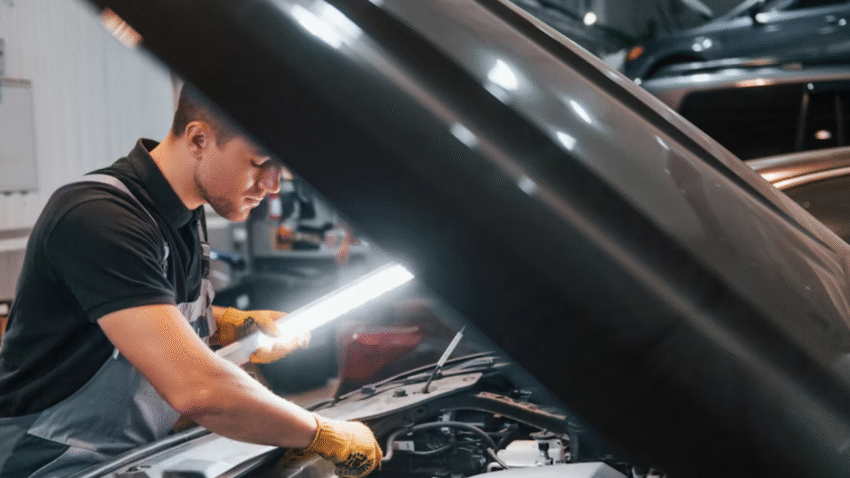Introduction
Fluorescent lights were once the go-to option for garages, workshops, and basements—but they have some downsides. They can flicker, hum, take time to warm up, and burn out faster than modern alternatives. Switching to LEDs offers brighter, more efficient, and longer-lasting lighting. Learning how to replace old fluorescent lights with LED fixtures is a straightforward upgrade that can transform your garage’s lighting, reduce your energy bills, and minimize maintenance.
Why Upgrade to LED Lighting
LED fixtures have become the preferred choice for homeowners and professionals for several reasons:
- Energy efficiency – LEDs use up to 60–80% less energy than fluorescent tubes.
- Longer lifespan – Many LED fixtures last 50,000 hours or more.
- Instant-on performance – No flickering or warm-up time.
- Better light quality – Higher color rendering index (CRI) for more accurate colors.
- Lower maintenance – Fewer bulb changes and reduced waste.
- Eco-friendly – No mercury or hazardous materials like fluorescents contain.
For garage environments, LEDs provide consistent, bright light that makes working on projects safer and more enjoyable.
Step-by-Step Guide to Replacing Fluorescent Lights with LED Fixtures
1. Choose Your Replacement Option
There are two main approaches:
- Full fixture replacement – Remove the old fluorescent fixture entirely and install a new LED fixture. This is the cleanest, most reliable option.
- LED retrofit tubes – Keep the existing fixture but replace fluorescent tubes with LED-compatible tubes. This can be faster but may require bypassing or removing the ballast.
For the best long-term results, many homeowners choose full fixture replacement.
2. Gather Tools and Materials
You’ll need:
- New LED fixtures or retrofit LED tubes.
- Screwdriver (Phillips or flathead).
- Wire stripper and cutter.
- Electrical tape.
- Wire connectors (wire nuts).
- Voltage tester.
- Ladder.
- Safety gear: gloves and safety glasses.
3. Turn Off the Power
Safety first:
- Switch off the light circuit at your breaker panel.
- Use a voltage tester on the fixture wires to ensure no electricity is flowing before touching anything.
4. Remove the Old Fluorescent Tubes
- Carefully twist each fluorescent tube 90 degrees to release it from the sockets.
- Lower it gently to avoid breakage—fluorescent tubes contain mercury and must be disposed of according to local hazardous waste guidelines.
5. Take Down the Old Fixture
- Remove the fixture cover or lens.
- Unscrew the fixture housing from the ceiling or mounting brackets.
- Lower the fixture and expose the wiring.
- Use the voltage tester again to confirm power is off.
6. Disconnect the Wiring
- Note how the wires are connected (take a picture for reference).
- Unscrew wire nuts and separate the fixture wires from the house wiring.
- If your old fixture has a ballast, you can remove it for recycling—LEDs don’t need one.
7. Prepare the Mounting Area
- Check that your electrical box is in good condition and securely fastened.
- If needed, repair or patch any holes in the ceiling before installing the new fixture.
8. Install the New LED Fixture
- Follow the manufacturer’s instructions for your specific fixture.
- Connect the LED fixture wires to the house wiring:
- Black (hot) to black.
- White (neutral) to white.
- Green or bare copper (ground) to green or bare copper.
- Use wire connectors and wrap connections with electrical tape for added security.
- Secure the fixture to the ceiling or mounting bracket using the provided screws.
9. Test the Fixture
- Restore power at the breaker.
- Turn on the switch to ensure the LED fixture lights up instantly.
- If it doesn’t work, turn off power again and recheck your connections.
10. Dispose of Old Fluorescent Bulbs and Ballast
- Take old tubes to a local hazardous waste facility or participating hardware store for recycling.
- If your ballast is labeled “No PCB” you can recycle it normally; otherwise, dispose of it as hazardous waste.
Common Mistakes to Avoid
- Not turning off the breaker
- Mistake: Relying only on the wall switch.
- Solution: Always cut power at the breaker for safety.
- Mixing up wires
- Mistake: Incorrectly connecting hot and neutral wires.
- Solution: Take photos of wiring before disassembly and match colors correctly.
- Keeping an old ballast with incompatible LED tubes
- Mistake: Installing ballast-bypass LEDs without removing or rewiring the ballast.
- Solution: Follow LED tube instructions carefully.
- Choosing the wrong LED color temperature
- Mistake: Picking overly warm or overly cool light for the garage.
- Solution: For garage/workshop use, 4000K–5000K (bright white/daylight) is ideal.
- Failing to recycle hazardous waste
- Mistake: Throwing fluorescent tubes in the trash.
- Solution: Recycle at approved facilities to prevent mercury contamination.
Extra Garage Tips & Hacks
- Opt for motion-sensor LED fixtures so lights turn on automatically when you enter the garage.
- Choose shatter-resistant LED tubes for added safety in workshop environments.
- Install multiple LED fixtures for even lighting across your work area.
- Related read: Check out our guide on upgrading garage electrical systems for modern lighting and tools.
Conclusion
Replacing old fluorescent lights with LED fixtures is one of the easiest and most impactful upgrades you can make to your garage. LEDs offer brighter, more efficient, and longer-lasting illumination—perfect for both everyday tasks and detailed workshop projects. By turning off the power, handling old tubes safely, and following proper wiring practices, you can complete this project in just a couple of hours.
Pro Tip: If you’re replacing multiple fixtures, consider upgrading all at once to ensure consistent light quality and avoid mismatched color temperatures.
